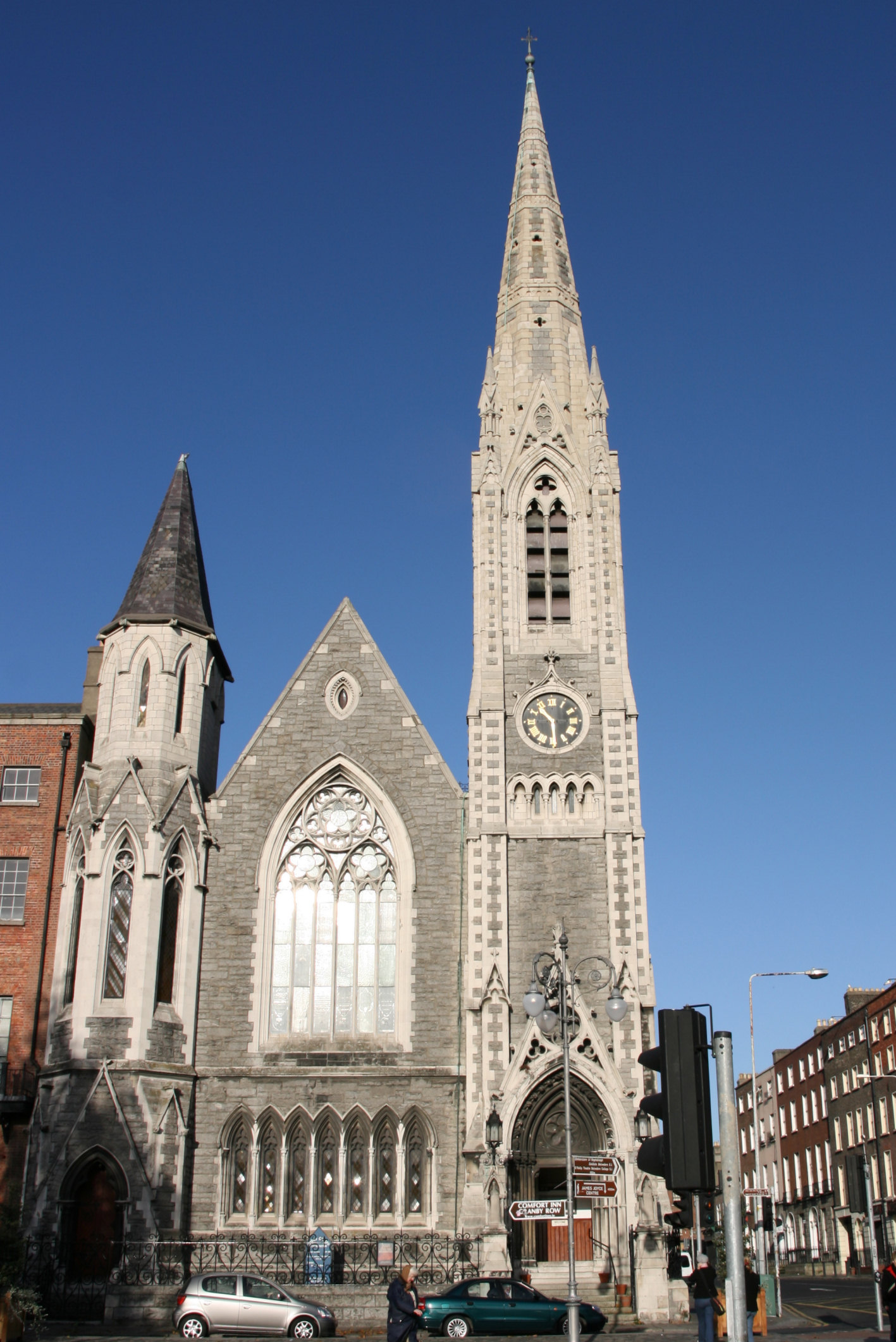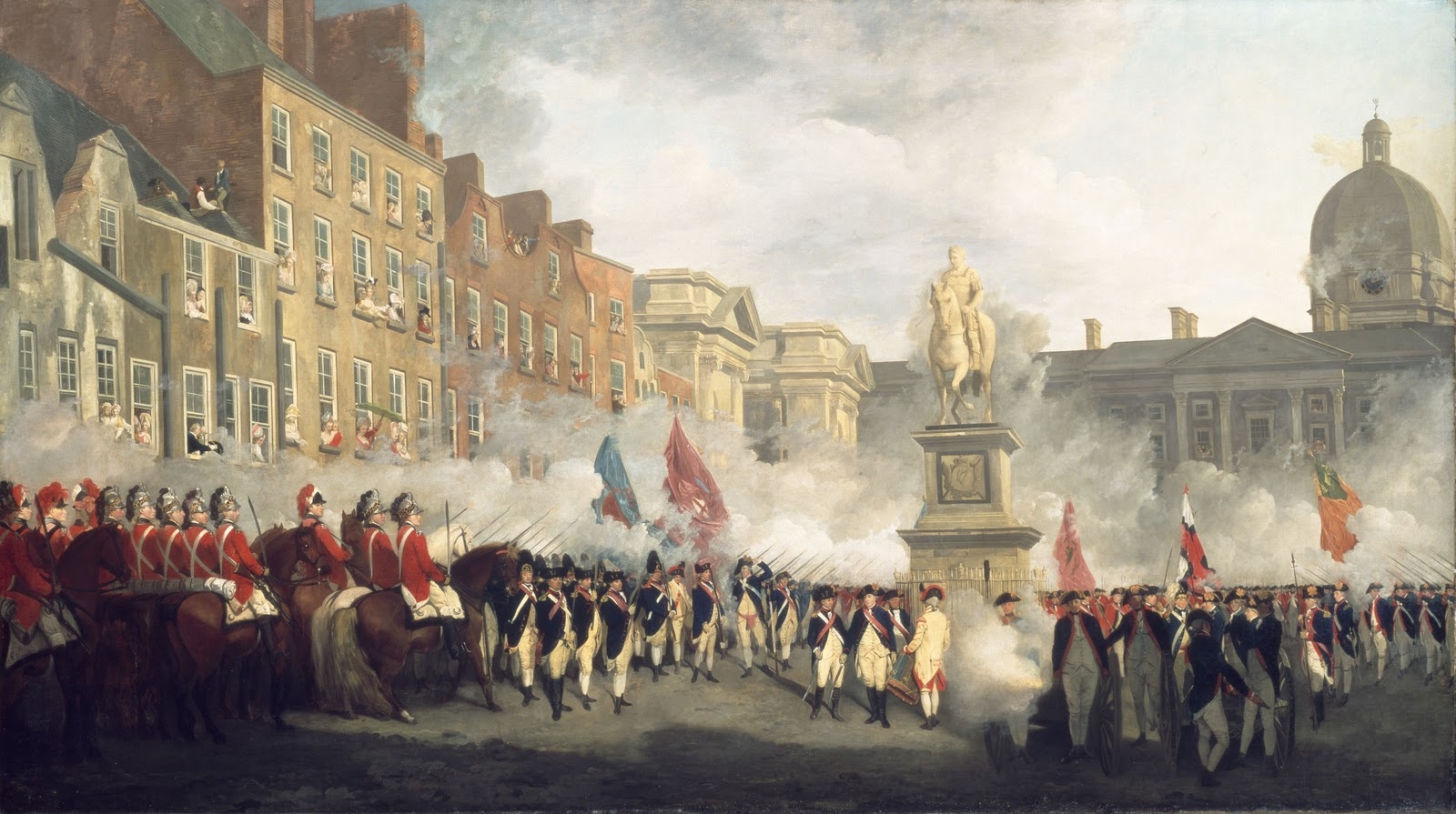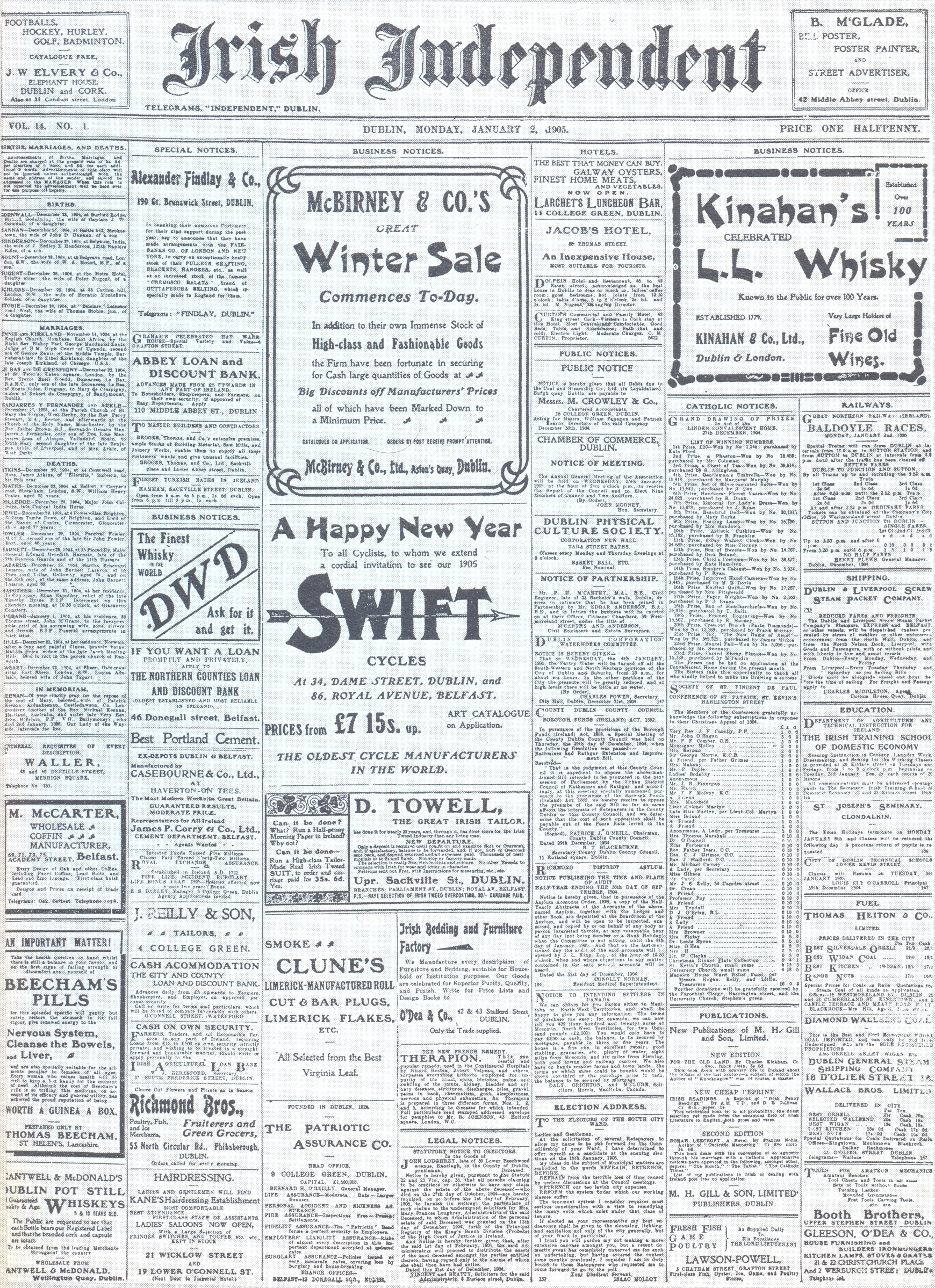|
O'Connell Monument, Dublin
The O'Connell Monument is a 40 ft high commemorative granite and bronze monument honouring nationalist leader Daniel O'Connell (1775–1847) located on O'Connell Street, the main thoroughfare of Dublin, Ireland. The monument consists of a two-ton Dalkey granite foundation stone, on top of which are seated four winged victories (at angles), encircled above by a bronze frieze of over 30 figures in high-relief symbolizing Irish culture, surmounted at the top by the tall cloaked figure of O'Connell (at about 2.5 times life-size) looking southwards. A small pile of books lies at the base of O'Connell's left leg. The O'Connell Monument was unveiled to the public on 15 August 1882 and the newly widened Carlisle Bridge was renamed O'Connell Bridge in honour of its new main focal point. What is now known as O'Connell Street, however, would remain named as Sackville Street until 1924. History After O'Connell's death in May 1847, it was considered prudent to create a monument ... [...More Info...] [...Related Items...] OR: [Wikipedia] [Google] [Baidu] |
O'Connell Bridge
O'Connell Bridge () is a road bridge spanning the River Liffey in Dublin, Ireland, which joins O'Connell Street to D'Olier Street, Westmoreland Street and the south quays. History The original bridge (named ''Carlisle Bridge'' for the then Lord Lieutenant of Ireland – Frederick Howard, 5th Earl of Carlisle) was designed by James Gandon, and built between 1791 and 1794. Originally humped, and narrower, ''Carlisle bridge'' was a symmetrical, three semicircular arch structure constructed in granite with a Portland stone balustrade and obelisks on each of the four corners. A keystone head at the apex of the central span symbolises the River Liffey, corresponding to the heads on the Custom House (also designed by James Gandon) which personify the other great rivers of Ireland. Since 1860, (following similar work on ''Essex Bridge'' – now Grattan Bridge), to improve the streetscape and relieve traffic congestion on the bridge, it was intended to widen Carlisle Bridge to b ... [...More Info...] [...Related Items...] OR: [Wikipedia] [Google] [Baidu] |
Dublin Castle Administration
Dublin (; , or ) is the capital and largest city of Ireland. On a bay at the mouth of the River Liffey, it is in the province of Leinster, bordered on the south by the Dublin Mountains, a part of the Wicklow Mountains range. At the 2016 census it had a population of 1,173,179, while the preliminary results of the 2022 census recorded that County Dublin as a whole had a population of 1,450,701, and that the population of the Greater Dublin Area was over 2 million, or roughly 40% of the Republic of Ireland's total population. A settlement was established in the area by the Gaels during or before the 7th century, followed by the Vikings. As the Kingdom of Dublin grew, it became Ireland's principal settlement by the 12th century Anglo-Norman invasion of Ireland. The city expanded rapidly from the 17th century and was briefly the second largest in the British Empire and sixth largest in Western Europe after the Acts of Union in 1800. Following independence in 1922, Dublin becam ... [...More Info...] [...Related Items...] OR: [Wikipedia] [Google] [Baidu] |
Parnell Square
Parnell Square () is a Georgian square sited at the northern end of O'Connell Street in the city of Dublin, Ireland. It is in the city's D01 postal district. Formerly named ''Rutland Square'', it was renamed after Charles Stewart Parnell (1846–1891), as was Parnell Street, which forms the southern side of the square. Surrounded on three sides by terraces of original intact Georgian houses, much of the southern part of the square and its centre is taken up by extensions of the Rotunda Hospital while the Garden of Remembrance is located along the northern side of this area. The main entrance to the Garden of Remembrance is on the eastern side of the square, with a smaller entrance on the northern side of the square. Notable buildings on the square The Gate Theatre and the Ambassador and Pillar Room venues are located at the southeastern corner of the square, where it meets O'Connell Street. Entertainments were originally developed here as part of the Rotunda Hospital scheme ... [...More Info...] [...Related Items...] OR: [Wikipedia] [Google] [Baidu] |
Volunteers Of 1782
The Volunteers (also known as the Irish Volunteers) were local militias raised by local initiative in Ireland in 1778. Their original purpose was to guard against invasion and to preserve law and order at a time when British soldiers were withdrawn from Ireland to fight abroad during the American Revolutionary War and the government failed to organise its own militia. Taking advantage of Britain's preoccupation with its rebelling American colonies, the Volunteers were able to pressure Westminster into conceding legislative independence to the Dublin parliament. Members of the Belfast 1st Volunteer Company laid the foundations for the establishment of the United Irishmen organisation. The majority of Volunteer members however were inclined towards the yeomanry, which fought and helped defeat the United Irishmen in the Irish rebellion of 1798.Ulster Museum, History of Belfast exhibition According to Bartlett, it was the Volunteers of 1782 which would launch a paramilitar ... [...More Info...] [...Related Items...] OR: [Wikipedia] [Google] [Baidu] |
Charles Dawson (Irish Politician)
Charles Dawson (1842 – 17 March 1917) was an Irish nationalist politician and a Member of Parliament (MP) for Carlow from 1880 to 1885. Born in Limerick, he was educated at Belvedere College Belvedere College S.J. (sometimes St Francis Xavier's College) is a voluntary secondary school for boys in Dublin, Ireland. The school has numerous alumni in the arts, politics, sports, science, and business. History Belvedere owes its origin ... and the Catholic University of Ireland. He was a member of Dublin Corporation in 1877 to 1884. He was Lord Mayor of Dublin from 1882 to 1883. He was elected as a Home Rule League MP for Carlow Borough at the 1880 general election. The Carlow Borough was abolished at the 1885 general election and Dawson chose to leave parliament to concentrate on his business activities. In 1873 Dawson married Katherine Carroll of Limerick city; they had four sons. References External links * 1842 births 1917 deaths Members of t ... [...More Info...] [...Related Items...] OR: [Wikipedia] [Google] [Baidu] |
Albert Memorial
The Albert Memorial, directly north of the Royal Albert Hall in Kensington Gardens, London, was commissioned by Queen Victoria in memory of her beloved husband Prince Albert, who died in 1861. Designed by Sir George Gilbert Scott in the Gothic Revival style, it takes the form of an ornate canopy or pavilion tall, in the style of a Gothic ciborium over the high altar of a church, sheltering a statue of the prince facing south. It took over ten years to complete, the £120,000 cost (the equivalent of about £10,000,000 in 2010) met by public subscription. The memorial was opened in July 1872 by Queen Victoria, with the statue of Albert ceremonially "seated" in 1876. It has been Grade I listed since 1970. Commission and design When Prince Albert died on 14 December 1861, at the age of 42, the thoughts of those in government and public life turned to the form and shape of a suitable memorial, with several possibilities, such as establishing a university or international scho ... [...More Info...] [...Related Items...] OR: [Wikipedia] [Google] [Baidu] |
City Hall, Dublin
The City Hall, Dublin (), originally the Royal Exchange, is a civic building in Dublin, Ireland. It was built between 1769 and 1779, to the designs of architect Thomas Cooley, and is a notable example of 18th-century architecture in the city. Originally used by the merchants of the city, it is today the formal seat of Dublin City Council. Location City Hall is located on a slope on Dame Street, at the southern end of Parliament Street, on Dublin's southern side. It stands in front of part of Dublin Castle, the centre of British government in Ireland until 1922. History The building occupied the site of what was formerly Cork House, the home of the Earl of Cork until his death in 1643, as well as Lucas’s Coffee-House. Parliament Street had been laid-out in 1753, providing a continuation of Capel Street on the north bank of the Liffey, across the newly widened Essex Bridge. Originally built as the ''Royal Exchange'', the structure was designed by Thomas Cooley, who ... [...More Info...] [...Related Items...] OR: [Wikipedia] [Google] [Baidu] |
Irish Builder
The ''Irish Builder'' was a successful trade journal published in Dublin, Ireland, under various names. Names used by the journal were: '' The Dublin Builder, or Illustrated Irish Architectural, Engineering, Mechanics’ & Sanitary Journal'' (1859-1866); ''Irish Builder and Engineering Record'' (1867-1871); ''Irish Builder'' (1872-1899); ''Irish Builder and Technical Journal'' to 1979. Its first proprietor and editor was an architect named J.J. Lyons.Tilley History and profile The ''Irish Builder'' was started as a successor to the ''Dublin Builder'' in 1867. Historical copies of the ''Dublin Builder'' are available to search and view in digitised form at The British Newspaper Archive The British Newspaper Archive web site provides access to searchable digitized archives of British and Irish newspapers. It was launched in November 2011. History The British Library Newspapers section was based in Colindale in north London, .... The ''Irish Builder'' appeared twice monthly ... [...More Info...] [...Related Items...] OR: [Wikipedia] [Google] [Baidu] |
The Irish Independent
The ''Irish Independent'' is an Republic of Ireland, Irish daily newspaper and online publication which is owned by Independent News & Media (INM), a subsidiary of Mediahuis. The newspaper version often includes glossy magazines. Traditionally a broadsheet newspaper, it introduced an additional Compact (newspaper), compact size in 2004. Further, in December 2012 (following billionaire Denis O'Brien's takeover) it was announced that the newspaper would become compact only. History Murphy and family (1905–1973) The ''Irish Independent'' was formed in 1905 as the direct successor to ''The Irish Daily Independent and Daily Nation'', an 1890s' pro-Charles Stewart Parnell, Parnellite newspaper. It was launched by William Martin Murphy, a controversial Irish nationalist businessman, staunch anti-Charles Stewart Parnell, Parnellite and fellow townsman of Parnell's most venomous opponent, Timothy Michael Healy from Bantry. The first issue of the ''Irish Independent'', published ... [...More Info...] [...Related Items...] OR: [Wikipedia] [Google] [Baidu] |
Dictionary Of Irish Biography
The ''Dictionary of Irish Biography'' (DIB) is a biographical dictionary of notable Irish people and people not born in the country who had notable careers in Ireland, including both Northern Ireland and the Republic of Ireland.Dictionary of Irish Biography 9 Volume Set History The work was supervised by a board of editors which included the historian . It was published as a nine-volume set in 2009 by |
Dublin City Council
Dublin City Council ( ga, Comhairle Cathrach Bhaile Átha Cliath) is the authority responsible for local government in the city of Dublin in Ireland. As a city council, it is governed by the Local Government Act 2001. Until 2001, the council was known as Dublin Corporation. The council is responsible for public housing and community, roads and transportation, urban planning and development, amenity and culture and environment. The council has 63 elected members and is the largest local council in Ireland. Elections are held every five years and are by single transferable vote. The head of the council has the honorific title of Lord Mayor. The city administration is headed by a Chief Executive, Owen Keegan. The council meets at City Hall, Dublin. Legal status Local government in Dublin is regulated by the Local Government Act 2001. This provided for the renaming of the old Dublin Corporation to its present title of Dublin City Council. Dublin City Council sends seven representat ... [...More Info...] [...Related Items...] OR: [Wikipedia] [Google] [Baidu] |
Peter Paul McSwiney
Peter Paul McSwiney ( 1810 – 27 February 1884) was an Irish politician and businessman. He was born in Cork city, son of John McSwiney, part of the prosperous catholic middle class in Cork. In 1852 McSwiney formed a partnership with draper George Delaney to open a store on Sackville Street, Dublin. He was elected to Dublin Corporation in 1860, and served as Lord Mayor of Dublin from 1864 to 1865, and again from 1875 to 1876. McSwiney proposed the placing of a statue of Daniel O'Connell (a distant relative) in Sackville Street, and on 8 August 1864 he laid the foundation stone. References {{DEFAULTSORT:McSwiney, Peter Paul 1810s births 1884 deaths Lord mayors of Dublin People from Cork (city) ... [...More Info...] [...Related Items...] OR: [Wikipedia] [Google] [Baidu] |





